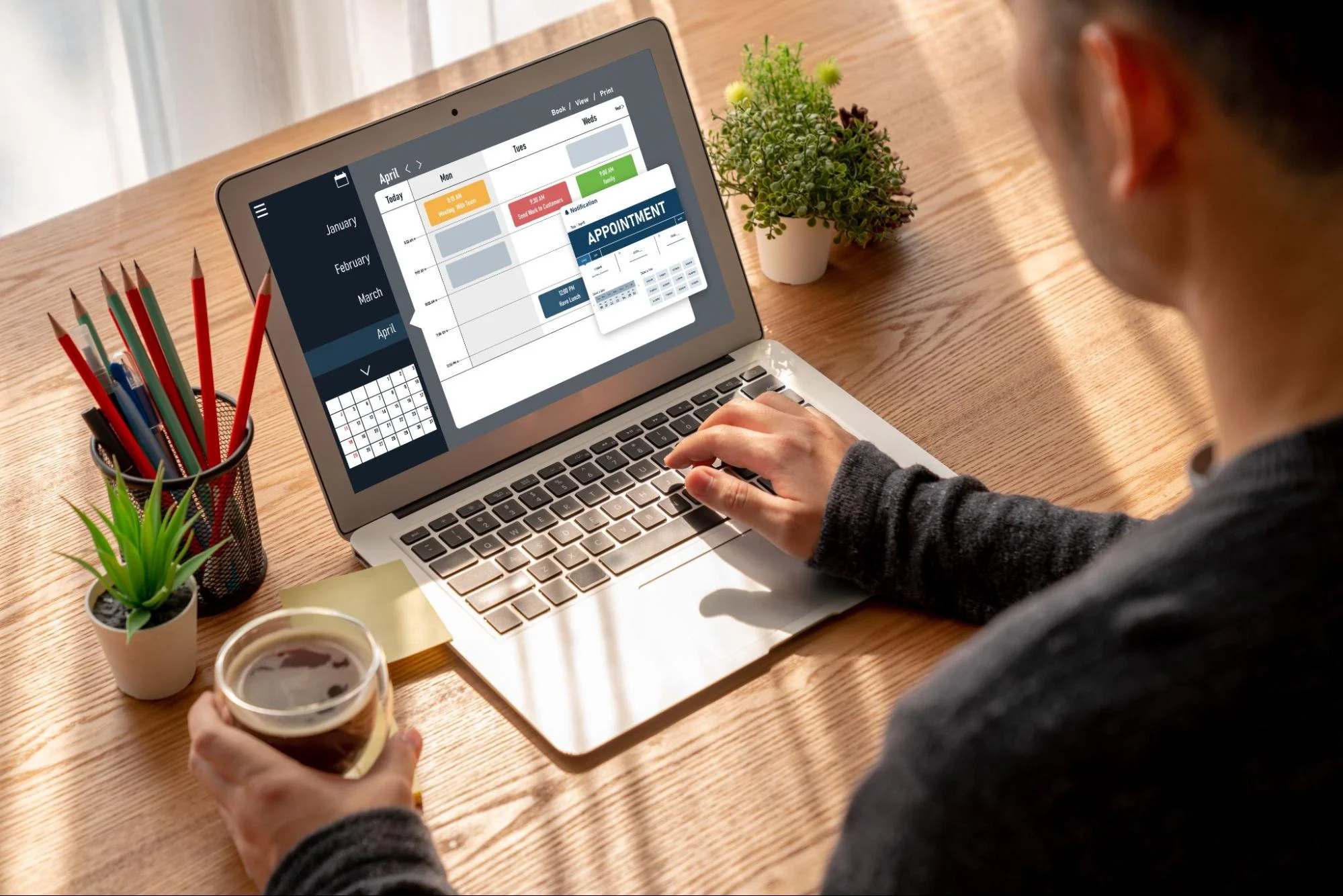How to increase inquiries and bookings for enterprise businesses

You know that your brand’s success depends on attracting new customers and encouraging existing customers to book more appointments. But you’re not sure how to increase inquiries and bookings for your enterprise business. From target brand advertising to social proof, here are eight ways you can draw attention to your services and keep a steady stream of appointments on your calendar.
1. Reach customers through targeted brand advertising

In the age of digital marketing campaigns, targeted brand advertising is one of the top ways to get noticed—and getting noticed means you’re generating more inquiries and bookings.
Targeted brand advertising involves any type of advertising that relies on data to target a specific audience. Paid search ads and paid social media ads are both types of targeted brand advertising that you can use to build a more robust online presence.
For example, let’s say you’re on the marketing team of a national medspa chain. You could use Yelp Search Ads to increase consideration among potential customers who are specifically searching for the services you offer, like facials or brow waxing. By highlighting your business in key places on Yelp.com and the Yelp mobile app, such as above or below relevant search results in the “Sponsored Results” sections and on your competitors’ pages, you can generate new leads by targeting a high-intent audience.
In addition, you could use Yelp Audiences to increase inquiries and bookings. By tapping into Yelp’s high-quality first-party data, you can retarget potential customers via Display, Video, Connected TV, and Dynamic Yelp Content Ads. For example, maybe you want to serve ads across the web to women aged 18-30, who live in a specific city, and have recently searched Yelp for the best brow waxing services.
If you’re ready to give targeted brand advertising a try, keep the following best practices in mind:
- Zero in on market trends and customer data to create highly specific audience segments so that you can place relevant ads in front of each segment. For example, a business like a medspa could use search-based data to target high-intent customers who have expressed interest in medspa services via their search histories.
- Improve ROI by finding the platforms that your audience frequents most. Some audiences may prefer one social site over another or may be more likely to visit local business platforms.
- Craft advertisements carefully so that they’re not only relevant to each segment, but also fresh and interesting. Be creative where possible—try calls to action (CTAs) like “Get your free goodies” or something else that captures attention. Avoid overused, nonspecific CTAs like “book now.”
- Remember that more is not always better in terms of ad frequency. Look at it from the potential customer’s perspective: It’s frustrating to be bombarded with the same series of advertisements across dozens of websites. Focus on placing ads in a few key places to attract attention without annoying customers and leverage frequency caps. Make sure you refresh creative often, as well, so that your message stays in front of your audience with minimal ad fatigue.
- Conduct regular A/B testing on your ads to determine which ones perform best in terms of messaging, design, format, offers, CTAs, and landing pages. When you pinpoint the best of them, continue to optimize—and test again—to refine them for even better results. Remember, consumer preferences change fairly frequently, so testing once is not enough to stay relevant.
2. Choose the right booking software
For national multi-location brands, booking software that works across all locations is crucial. When you have customers who are at the bottom of the sales funnel, ready to convert, the booking process is the last step—and if it proves difficult, would-be customers are likely to browse away in search of more accessible options.
Software that offers a good user experience encourages not only first-time bookings but also repeat bookings. For example, let’s say a new patient wants to schedule a visit with a doctor’s office. The booking system should make it easy for the patient to select a day and time and choose their preferred physician. If the patient needs to book a follow-up appointment, the system should remember their previous physician to make it easier to book with this provider again the next time.
Many popular customer relationship management systems (CRMs) like Salesforce and Hubspot also integrate with booking software. So if you already have a CRM in mind, you may not need to search any further.
A user-friendly booking system should let you do the following:
- Create online bookings, and get confirmations in real time
- Make online payments, and add online tips
- Use promo codes and gift cards
- Receive automated email reminders
- Make bookings on any device, including mobile devices
- Make manual entries for when people call to book appointments
Booking software should also help your business streamline and automate with the following key features:
- Update provider schedules with new bookings
- Generate reports featuring provider performance data
- Store customer data to improve checkout experiences
- Manage travel times and costs for service providers who travel to their customers
3. Make it easy for customers to contact you

Have you ever tried to call a service provider—like a plumber—only to discover that no one is answering the one phone number provided on the website? Frustrated customers in this position may choose to go somewhere else to book services like emergency leak detection or full-home repiping jobs.
That’s why you need to make it easy for customers to contact you if you want to improve lead generation and increase conversion rates.
There are a variety of ways to encourage customer inquiries:
- Make it easy to place a phone call or send an email by displaying phone numbers and email addresses prominently on all pages of your website and keeping contact information up-to-date on your Yelp Page
- If you’re in a services category, respond to requests for quotes, availability, consultations, and more from Yelp’s Request a Quote feature. Make sure you have messaging enabled for each location so potential customers can contact you through the platform. (Contact your Yelp Account team for help enabling messages for multiple locations.)
- Avoid relying on overburdened staffers to answer the phone and instead delegate this task to a customer service representative
- Use chatbots on your website to answer basic customer questions
- Leverage messaging on social media to connect and provide information
- Give customers the option for automatic callbacks so that they don’t have to wait on the line when hold times are long
4. Make social proof a priority
Let’s say that one customer—we’ll call her Jane—had a particularly great experience getting routine maintenance (e.g., oil changes, tire rotations) at an auto service shop. She leaves a glowingly positive review for the business. What’s more, when Jane’s having coffee with her friends, one of them mentions that her car needs an oil change. Jane brings up the fantastic experience she just had, and because her friend trusts Jane’s opinion, she is now inclined to trust Jane’s recommendation.
That’s an example of the power of social proof. With it, you can increase interest among your target audience and build trust. That leads to more inquiries and higher numbers of bookings.
Here are some ways to leverage it:
- Boost word-of-mouth with a referral plan that offers incentives any time an existing customer refers a new customer.
- Share your well-earned positive reviews across channels, highlighting your favorites on your website or sharing review screenshots on other social platforms.
- To maintain integrity in your social proof, don’t ask or prompt customers for reviews. Asking customers to write reviews often comes across as cheesy and inauthentic, and will ultimately diminish your brand trust among consumers.
5. Increase repeat bookings

Fostering repeat bookings not only increases overall sales but helps you improve your bottom line. The idea behind encouraging repeat bookings is to lower customer churn so that you can increase retention.
When you successfully lower churn, you can decrease customer acquisition costs (CAC). It varies per industry and per brand, but research suggests that it costs between five and seven times more to acquire a new customer as opposed to retaining an existing one.
Plus, your customer lifetime value (LTV) metric will go up with existing customers because you’ll see consistent revenue coming in from them on regular rebooked services, and you’ll have opportunities to upsell them to additional services.
Customers for a lawn care service, for example, may book a provider to have their lawn aerated and fertilized. Having gotten great results from this experience, when they come back to the lawn care provider, they may require additional services, like reseeding or weed control. Customers who are really thrilled might even sign up for a lawn care package that includes a variety of services like fertilizing, seeding, weed control, and mowing—all spread out over the course of the summer.
To encourage additional bookings, try the following:
- Use email marketing to nurture existing leads by sending out follow-up emails that encourage them to book future appointments
- Make the customer experience easy by giving them the ability to create accounts that save payment information and preferences, including favorite services and locations
- Create discounted service packages that bundle multiple services or appointments so that you can attract customers with savings while guaranteeing future bookings
- Implement a customer loyalty program that offers opportunities to earn and use rewards points, discounts, and other incentives
6. Create the content that your audience needs
Content marketing is a broad term that encompasses many kinds of formats: social media posts, landing pages, service page content, content for location pages, blogs, and more.
Once customers discover your brand, content marketing is what nurtures them through the sales funnel until they convert and book a service with your brand. Content is a great way to build trust and quiet qualms by offering key information customers will need to make a purchase decision.
How do you tell which types of content your audience needs? Put yourself in the customer’s shoes.
For example, you’ll need to create service pages to inform customers what you have to offer. You can also create blogs or informative pages illustrating what customers should expect before, during, and after your services.
Here are some considerations that will help you discover which types of content can turn searches into booked appointments:
- Familiarize yourself with the customer journey to learn which specific types of assets are most useful at each stage. Understand what excites them, and build on that; uncover what makes them anxious or concerned, and address that.
- Learn about the common questions customers are asking, then answer them, either through FAQ pages or a series of blogs that detail what they want to know.
- Build an understanding of the key problems that your service offerings can solve for customers. Create service pages, landing pages, and blogs that illustrate how your services solve these problems.
- Include helpful non-branded content in the mix to build trust and goodwill. For example, hotel chains can create pages or blogs devoted to popular restaurants and attractions near each hotel location or even provide recommendations for travel agents who can help plan a fun trip in the area.
The last step is getting people to see your content. That means helping it get discovered via SEO, paid ads, influencer marketing, brand/business partnerships, or other types of promotion.
7. Lean into local marketing

With a local marketing strategy, you can target customers in areas where your services or store locations are available. For national brands and multi-location service providers, local marketing is a crucial way to get your offerings out in front of the customers most likely to book them.
What makes this tactic so important? If customers in Cleveland, Ohio, are searching for a house cleaning service, they don’t want to see ads for locations that offer these services in California. Instead, they want cleaners who are local to them. If you have locations that service Cleveland, you can lean heavily on local marketing to place your ads and your brand ahead of the competition in the area so that when customers start searching, your brand’s nearby location is the first one that they see.
These strategies will help you maximize your local marketing efforts:
- Create location-specific content like individual store pages—and be sure to leverage local search engine optimization (SEO) to help these pages appear in local searches
- Remember that needs and preferences differ from one region to another, which is why local advertising campaigns should be customized to suit each region
- Run geo-targeted promotions to attract the interest of customers within each specific service area
- Create partnerships with local influencers and area businesses to help get the word out about your brand’s local services
8. Rethink your approach to the low season
For many service-based industries, business waxes and wanes throughout the year. For example, general contractors and roofers often experience seasonal lulls in the winter—and business may also lag when interest rates are high and homeowners are reluctant to take out loans for new builds or renovations. A lack of bookings during these dry spells can prove costly. Where possible, it’s better to adjust your approach to the low season so that you can bring booking numbers up and keep on generating revenue, even when there aren’t as many potential clients clamoring for building, repair, or renovation projects.
Here are some ideas:
- Review your pricing strategy. During peak times, your locations may be able to command higher prices so that you can offset any discounts that you may offer to attract bookings during less busy periods.
- Is there a different but related service you can provide during seasonal lulls? For example, many landscapers will offer snow removal and plowing during the winter months instead of lawn care services.
- If some of your locations experience slower periods, chances are, other area businesses are too. Home improvement stores or lumberyards may have fewer customers, for instance. Partner with some of these enterprises to offer discounts that attract customers to both businesses during the off-season.
- If your business is affected by economic factors like higher interest rates, you might want to consider offering interest-free payment plans or in-house financing with lower rates to encourage customers to take on bigger-ticket projects.
- List your enterprise with booking engines or business directories to help put your business in front of as many searchers as possible. This can make it much easier for people to find you.
- Enable messages on Yelp to open up a new stream of leads from Request a Quote year-round. Over 85,000 new requests for projects and other messages are sent to businesses on Yelp every day.*
Pick your strategies to increase inquiries and bookings for your enterprise business
Consistently increasing inquiries and bookings for enterprise businesses is challenging. Targeted brand advertising across paid search and social media platforms are essential strategies. You can also give bookings a boost by fostering social proof, leveraging local marketing, creating content according to customer needs, and of course, by ensuring that it’s easy for customers to contact you and learn more about your brand. It’s also wise to target your existing customers with email marketing and special offers to encourage them to come back for more.
On top of these tactics, you’ll also need powerful tools that can help you maximize your ROI. Booking software is a must because it allows you to automate the booking process across all locations.
You can also schedule a strategy call with Yelp for Brands to learn more about advanced solutions and services that can help you increase bookings across all of your locations.